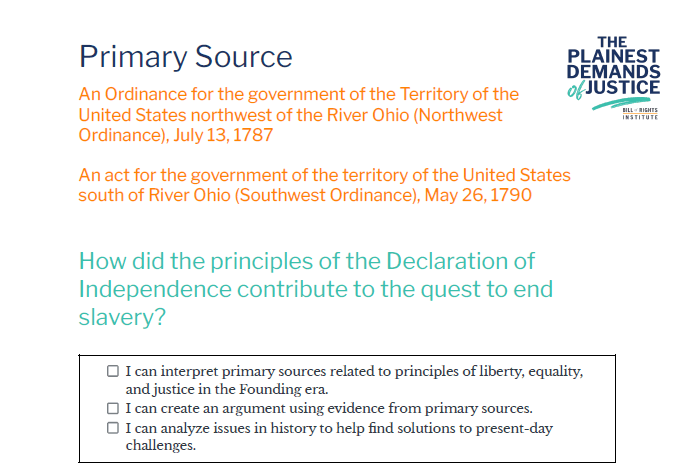The Northwest Ordinance, 1787 and the Southwest Ordinance, 1790
How did the principles of the Declaration of Independence contribute to the quest to end slavery?
- I can interpret primary sources related to principles of liberty, equality, and justice in the Founding era.
- I can create an argument using evidence from primary sources.
- I can analyze issues in history to help find solutions to present-day challenges.
Essential Vocabulary
| Ordinance | Law |
| Conveyed | Transported |
Building Context
Passed by Congress under the Articles of Confederation, the Northwest Ordinance of 1787 promised republican self-government to the inhabitants of the developing territory lying between the Great Lakes and the Ohio River. This ordinance also set the rules for creating new states. It banned slavery in those states and established the authority for Congress to regulate slavery in the territories. A similar land ordinance or law was passed in 1790 by the first Congress under the U.S. Constitution, for the territory south of the Ohio River that permitted slavery.
An Ordinance for the government of the Territory of the United States northwest of the River Ohio (Northwest Ordinance), July 13, 1787
Source: https://avalon.law.yale.edu/18th_century/nworder.asp
Art. 2. … No man shall be deprived of his liberty or property, but by the judgment of his peers or the law of the land…
…
Art. 6. There shall be neither slavery nor involuntary servitude in the said territory, otherwise than in the punishment of crimes whereof the party shall have been duly convicted: Provided, always, That any person escaping into the same, from whom labor or service is lawfully claimed in any one of the original States, such fugitive may be lawfully reclaimed and conveyed [transported] to the person claiming his or her labor or service as aforesaid.
An act for the government of the territory of the United States south of River Ohio (Southwest Ordinance), May 26, 1790
Source: https://constitution.org/1-Law/uslaw/southwest_ordinance.pdf
SECTION 1. … the government of the said territory south of the Ohio, shall be similar to that which is now exercised in the territory northwest of the Ohio; except so far as is otherwise provided in the conditions expressed in an act of Congress of the present session, entitled “An act to accept a cession of the claims of the State of North Carolina, to a certain district of western territory.”
Note: “An act to accept a cession of the claims of the State of North Carolina, to a certain district of western territory” was passed by the Congress the prior month and included the following language:
… all the lands intended to be ceded by virtue of this act to the United States of America…shall be considered as a common fund for the use and benefit of the United States of America… Provided always, That no regulations made or to be made by Congress, shall tend to emancipate slaves.
Comprehension and Analysis Questions
- What was the purpose of these two documents?
- What do these two documents each say about the condition of slavery?
- What do these documents reveal about geography and the institution of slavery by 1790?
- The Constitutional Convention met from May to September 1787, and the Northwest Ordinance was passed in July. What might this tell us about the national conversation regarding slavery at the time?
